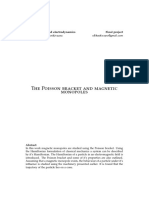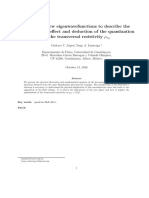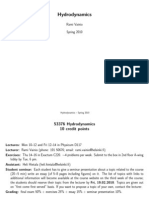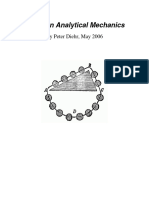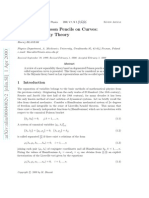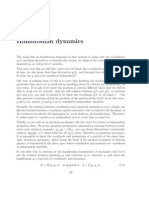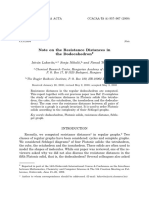Motion of A Charged Particle in A Magnetic Field
Motion of A Charged Particle in A Magnetic Field
Uploaded by
James MaxwellCopyright:
Available Formats
Motion of A Charged Particle in A Magnetic Field
Motion of A Charged Particle in A Magnetic Field
Uploaded by
James MaxwellOriginal Title
Copyright
Available Formats
Share this document
Did you find this document useful?
Is this content inappropriate?
Copyright:
Available Formats
Motion of A Charged Particle in A Magnetic Field
Motion of A Charged Particle in A Magnetic Field
Uploaded by
James MaxwellCopyright:
Available Formats
Chapter 5
Motion of a charged particle
in a magnetic eld
Hitherto, we have focussed on applications of quantum mechanics to free parti-
cles or particles conned by scalar potentials. In the following, we will address
the inuence of a magnetic eld on a charged particle. Classically, the force on
a charged particle in an electric and magnetic eld is specied by the Lorentz
force law:
Hendrik Antoon Lorentz 1853-
1928
A Dutch physi-
cist who shared
the 1902 Nobel
Prize in Physics
with Pieter Zee-
man for the dis-
covery and the-
oretical explana-
tion of the Zee-
man eect. He
also derived the transformation equa-
tions subsequently used by Albert
Einstein to describe space and time.
F = q (E+v B) ,
where q denotes the charge and v the velocity. (Here we will adopt a convention
in which q denotes the charge (which may be positive or negative) and e |e|
denotes the modulus of the electron charge, i.e. for an electron, the charge
q = e = 1.602176487 10
19
C.) The velocity-dependent force associated
with the magnetic eld is quite dierent from the conservative forces associated
with scalar potentials, and the programme for transferring from classical to
quantum mechanics - replacing momenta with the appropriate operators - has
to be carried out with more care. As preparation, it is helpful to revise how
the Lorentz force arises in the Lagrangian formulation of classical mechanics.
Joseph-Louis Lagrange, born
Giuseppe Lodovico Lagrangia
1736-1813
An Italian-born
mathematician
and astronomer,
who lived most
of his life in
Prussia and
France, mak-
ing signicant
contributions
to all elds of analysis, to number
theory, and to classical and celestial
mechanics. On the recommendation
of Euler and DAlembert, in 1766
Lagrange succeeded Euler as the
director of mathematics at the
Prussian Academy of Sciences in
Berlin, where he stayed for over
twenty years, producing a large
body of work and winning several
prizes of the French Academy of
Sciences. Lagranges treatise on
analytical mechanics, written in
Berlin and rst published in 1788,
oered the most comprehensive
treatment of classical mechanics
since Newton and formed a basis for
the development of mathematical
physics in the nineteenth century.
5.1 Classical mechanics of a particle in a eld
For a system with m degrees of freedom specied by coordinates q
1
, q
m
, the
classical action is determined from the Lagrangian L(q
i
, q
i
) by
S[q
i
] =
_
dt L(q
i
, q
i
) .
The action is said to be a functional of the coordinates q
i
(t). According
to Hamiltons extremal principle (also known as the principle of least
action), the dynamics of a classical system is described by the equations that
minimize the action. These equations of motion can be expressed through the
classical Lagrangian in the form of the Euler-Lagrange equations,
d
dt
(
q
i
L(q
i
, q
i
))
q
i
L(q
i
, q
i
) = 0 . (5.1)
Info. Euler-Lagrange equations: According to Hamiltons extremal princi-
ple, for any smooth set of curves w
i
(t), the variation of the action around the classical
solution q
i
(t) is zero, i.e. lim
0
1
(S[q
i
+ w
i
] S[q
i
]) = 0. Applied to the action,
Advanced Quantum Physics
5.1. CLASSICAL MECHANICS OF A PARTICLE IN A FIELD 45
the variation implies that, for any i,
_
dt (w
i
qi
L(q
i
, q
i
) + w
i
qi
L(q
i
, q
i
)) = 0. Then,
integrating the second term by parts, and droping the boundary term, one obtains
_
dt w
i
_
qi
L(q
i
, q
i
)
d
dt
qi
L(q
i
, q
i
)
_
= 0 .
Since this equality must follow for any function w
i
(t), the term in parentheses in the
integrand must vanish leading to the Euler-Lagrange equation (5.1).
The canonical momentum is specied by the equation p
i
=
q
i
L, and
the classical Hamiltonian is dened by the Legendre transform,
H(q
i
, p
i
) =
i
p
i
q
i
L(q
i
, q
i
) . (5.2)
It is straightforward to check that the equations of motion can be written in
the form of Hamiltons equations of motion,
q
i
=
p
i
H, p
i
=
q
i
H .
From these equations it follows that, if the Hamiltonian is independent of a
particular coordinate q
i
, the corresponding momentum p
i
remains constant.
For conservative forces,
1
the classical Lagrangian and Hamiltonian can be
written as L = T V , H = T + V , with T the kinetic energy and V the
potential energy.
Simeon Denis Poisson 1781-
1840
A French
mathematician,
geometer, and
physicist whose
mathematical
skills enabled
him to compute
the distribution
of electrical
charges on the surface of conduc-
tors. He extended the work of his
mentors, Pierre Simon Laplace and
Joseph Louis Lagrange, in celestial
mechanics by taking their results to a
higher order of accuracy. He was also
known for his work in probability.
Info. Poisson brackets: Any dynamical variable f in the system is some
function of the phase space coordinates, the q
i
s and p
i
s, and (assuming it does not
depend explicitly on time) its time-development is given by:
d
dt
f(q
i
, p
i
) =
qi
f q
i
+
pi
f p
i
=
qi
f
pi
H
pi
f
qi
H {f, H}.
The curly brackets are known as Poisson brackets, and are dened for any dynamical
variables as {A, B} =
qi
A
pi
B
pi
A
qi
B. From Hamiltons equations, we have
shown that for any variable,
f = {f, H}. It is easy to check that, for the coordinates
and canonical momenta, {q
i
, q
j
} = 0 = {p
i
, p
j
}, {q
i
, p
j
} =
ij
. This was the
classical mathematical structure that led Dirac to link up classical and quantum
mechanics: He realized that the Poisson brackets were the classical version of the
commutators, so a classical canonical momentum must correspond to the quantum
dierential operator in the corresponding coordinate.
2
With these foundations revised, we now return to the problem at hand; the
ineunce of an electromagnetic eld on the dynamics of the charged particle.
As the Lorentz force is velocity dependent, it can not be expressed simply
as the gradient of some potential. Nevertheless, the classical path traversed by
a charged particle is still specifed by the principle of least action. The electric
and magnetic elds can be written in terms of a scalar and a vector potential
as B = A, E =
A. The corresponding Lagrangian takes the form:
3
L =
1
2
mv
2
q + qv A.
1
i.e. forces that conserve mechanical energy.
2
For a detailed discussion, we refer to Paul A. M. Dirac, Lectures on Quantum Mechanics,
Belfer Graduate School of Science Monographs Series Number 2, 1964.
3
In a relativistic formulation, the interaction term here looks less arbitrary: the relativistic
version would have the relativistically invariant q
R
A
dx added to the action integral, where
the four-potential A = (, A) and dx = (ct, dx1, dx2, dx3). This is the simplest possible
invariant interaction between the electromagnetic eld and the particles four-velocity. Then,
in the non-relativistic limit, q
R
A
dx just becomes q
R
(v A)dt.
Advanced Quantum Physics
5.2. QUANTUM MECHANICS OF A PARTICLE IN A FIELD 46
In this case, the general coordinates q
i
x
i
= (x
1
, x
2
, x
3
) are just the Carte-
sian coordinates specifying the position of the particle, and the q
i
are the three
components x
i
= ( x
1
, x
2
, x
3
) of the particle velocities. The important point is
that the canonical momentum
p
i
=
x
i
L = mv
i
+ qA
i
,
is no longer simply given by the mass velocity there is an extra term!
Making use of the denition (5.2), the corresponding Hamiltonian is given
by
H(q
i
, p
i
) =
i
(mv
i
+ qA
i
) v
i
1
2
mv
2
+ q qv A =
1
2
mv
2
+ q.
Reassuringly, the Hamiltonian just has the familiar form of the sum of the
kinetic and potential energy. However, to get Hamiltons equations of motion,
the Hamiltonian has to be expressed solely in terms of the coordinates and
canonical momenta, i.e.
H =
1
2m
(p qA(r, t))
2
+ q(r, t) .
Let us now consider Hamiltons equations of motion, x
i
=
p
i
H and
p
i
=
x
i
H. The rst equation recovers the expression for the canonical
momentum while second equation yields the Lorentz force law. To under-
stand how, we must rst keep in mind that dp/dt is not the acceleration: The
A-dependent term also varies in time, and in a quite complicated way, since
it is the eld at a point moving with the particle. More precisely,
p
i
= m x
i
+ q
A
i
= m x
i
+ q
_
t
A
i
+ v
j
x
j
A
i
_
,
where we have assumed a summation over repeated indicies. The right-hand
side of the second of Hamiltons equation, p
i
=
H
x
i
, is given by
x
i
H =
1
m
(p qA(r, t))q
x
i
Aq
x
i
(r, t) = qv
j
x
i
A
j
q
x
i
.
Together, we obtain the equation of motion, m x
i
= q
_
t
A
i
+ v
j
x
j
A
i
_
+
qv
j
x
i
A
j
q
x
i
. Using the identity, v (A) = (v A) (v )A, and
the expressions for the electric and magnetic elds in terms of the potentials,
one recovers the Lorentz equations
m x = F = q (E+v B) .
With these preliminary discussions of the classical system in place, we are now
in a position to turn to the quantum mechanics.
5.2 Quantum mechanics of a particle in a eld
To transfer to the quantum mechanical regime, we must once again implement
the canonical quantization procedure setting p = i, so that [ x
i
, p
j
] =
i
ij
. However, in this case, p
i
= m v
i
. This leads to the novel situation that
the velocities in dierent directions do not commute.
4
To explore inuence of
the magnetic eld on the particle dynamics, it is helpful to assess the relative
weight of the A-dependent contributions to the quantum Hamiltonian,
H =
1
2m
( p qA(r, t))
2
+ q(r, t) .
4
With m vi = ix
i
qAi, it is easy (and instructive) to verify that [ vx, vy] =
iq
m
2
B.
Advanced Quantum Physics
5.3. ATOMIC HYDROGEN: NORMAL ZEEMAN EFFECT 47
Expanding the square on the right hand side of the Hamiltonian, the
cross-term (known as the paramagnetic term) leads to the contribution
q
2im
( A+A ) =
iq
m
A , where the last equality follows from the
Coulomb gauge condition, A = 0.
5
Combined with the diamagnetic (A
2
)
contribution, one obtains the Hamiltonian,
H =
2
2m
2
+
iq
m
A +
q
2
2m
A
2
+ q.
For a constant magnetic eld, the vector potential can be written as A =
r B/2. In this case, the paramagnetic component takes the form
iq
m
A =
iq
2m
(r ) B =
q
2m
L B,
where L denotes the angular momentum operator (with the hat not shown for
brevity!). Similarly, the diamagnetic term leads to
q
2
2m
A
2
=
q
2
8m
_
r
2
B
2
(r B)
2
_
=
q
2
B
2
8m
(x
2
+ y
2
) ,
where, here, we have chosen the magnetic eld to lie along the z-axis.
5.3 Atomic hydrogen: Normal Zeeman eect
Before addressing the role of these separate contributions in atomic hydrogen,
let us rst estimate their relative magnitude. With x
2
+ y
2
a
2
0
, where a
0
denotes the Bohr radius, and L
z
, the ratio of the paramagnetic and
diamagnetic terms is given by
(q
2
/8m
e
)x
2
+ y
2
B
2
(q/2m
e
)L
z
B
=
e
4
a
2
0
B
2
B
10
6
B/T.
Therefore, while electrons remain bound to atoms, for elds that can be
achieved in the laboratory (B 1 T), the diamagnetic term is negligible as
compared to the paramagnetic term. Moreover, when compared with the
Coulomb energy scale,
eB/2m
e
m
e
c
2
2
/2
=
e
(m
e
c)
2
B
B/T
2.3 10
5
,
where =
e
2
4
0
1
c
1
137
denotes the ne structure constant, one may see
that the paramagnetic term provides only a small perturbation to the typical
atomic splittings.
Splitting of the sodium D lines
due to an external magnetic eld.
The multiplicity of the lines and
their selection rule will be dis-
cussed more fully in chapter 9.
The gure is taken from the orig-
inal paper, P. Zeeman, The eect
of magnetization on the nature of
light emitted by a substance, Na-
ture 55, 347 (1897).
5
The electric eld E and magnetic eld B of Maxwells equations contain only physical
degrees of freedom, in the sense that every mathematical degree of freedom in an electromag-
netic eld conguration has a separately measurable eect on the motions of test charges in
the vicinity. As we have seen, these eld strength variables can be expressed in terms of
the scalar potential and the vector potential A through the relations: E = tA
and B = A. Notice that if A is transformed to A + , B remains unchanged, since
B = [A+] = A. However, this transformation changes E as
E = tAt = [ + t] tA.
If is further changed to t, E remains unchanged. Hence, both the E and B elds
are unchanged if we take any function (r, t) and simultaneously transform
A A+
t.
A particular choice of the scalar and vector potentials is a gauge, and a scalar function
used to change the gauge is called a gauge function. The existence of arbitrary numbers of
gauge functions (r, t), corresponds to the U(1) gauge freedom of the theory. Gauge xing
can be done in many ways.
Advanced Quantum Physics
5.4. GAUGE INVARIANCE AND THE AHARONOV-BOHM EFFECT 48
However, there are instances when the diamagnetic contriubution can play
an important role. Leaving aside the situation that may prevail on neutron
stars, where magnetic elds as high as 10
8
T may exist, the diamagnetic con-
tribution can be large when the typical orbital scale x
2
+ y
2
becomes
macroscopic in extent. Such a situation arises when the electrons become
unbound such as, for example, in a metal or a synchrotron. For a further
discussion, see section 5.5 below.
Retaining only the paramagnetic contribution, the Hamiltonian for a spin-
less electron moving in a Coulomb potential in the presence of a constant
magnetic eld then takes the form,
H =
H
0
+
e
2m
BL
z
,
where
H
0
=
p
2
2m
e
2
4
0
r
. Since [
H
0
, L
z
] = 0, the eigenstates of the unperturbed
Hamiltonian,
lm
(r) remain eigenstates of
H and the corresponding energy
levels are specied by
E
nm
=
Ry
n
2
+
L
m
where
L
=
eB
2m
denotes the Larmor frequency. From this result, we expect
that a constant magnetic eld will lead to a splitting of the (2+1)-fold degen-
eracy of the energy levels leading to multiplets separated by a constant energy
shift of
L
. The fact that this behaviour is not recapitulated generically by
experiment was one of the key insights that led to the identication of electron
spin, a matter to which we will turn in chapter 6.
Sir Joseph Larmor 1857-1942
A physicist and
mathematician
who made in-
novations in the
understanding
of electricity,
dynamics, ther-
modynamics,
and the electron theory of matter.
His most inuential work was Aether
and Matter, a theoretical physics
book published in 1900. In 1903 he
was appointed Lucasian Professor of
Mathematics at Cambridge, a post
he retained until his retirement in
1932.
5.4 Gauge invariance and the Aharonov-Bohm ef-
fect
Our derivation above shows that the quantum mechanical Hamiltonian of a
charged particle is dened in terms of the vector potential, A. Since the latter
is dened only up to some gauge choice, this suggests that the wavefunction
is not a gauge invariant object. Indeed, it is only the observables associated
with the wavefunction which must be gauge invariant. To explore this gauge
freedom, let us consider the inuence of the gauge transformation,
A A
= A+,
t
,
where (r, t) denotes a scalar function. Under the gauge transformation, one
may show that the corresponding wavefunction gets transformed as
(r, t) = exp
_
i
q
(r, t)
_
(r, t) . (5.3)
Exercise. If wavefunction (r, t) obeys the time-dependent Schrodinger equa-
tion, i
t
=
H[A, ], show that
(r, t) as dened by (5.3) obeys the equation
i
t
=
H
[A
.
The gauge transformation introduces an additional space and time-dependent
phase factor into the wavefunction. However, since the observable translates
to the probability density, ||
2
, this phase dependence seems invisible.
Info. One physical manifestation of the gauge invariance of the wavefunction
is found in the Aharonov-Bohm eect. Consider a particle with charge q travelling
Advanced Quantum Physics
5.4. GAUGE INVARIANCE AND THE AHARONOV-BOHM EFFECT 49
Figure 5.1: (Left) Schematic showing the geometry of an experiment to observe the
Aharonov-Bohm eect. Electrons from a coherent source can follow two paths which
encircle a region where the magnetic eld is non-zero. (Right) Interference fringes
for electron beams passing near a toroidal magnet from the experiment by Tonomura
and collaborators in 1986. The electron beam passing through the center of the torus
acquires an additional phase, resulting in fringes that are shifted with respect to
those outside the torus, demonstrating the Aharonov-Bohm eect. For details see the
original paper from which this image was borrowed see Tonomura et al., Evidence
for Aharonov-Bohm eect with magnetic eld completely shielded from electron wave,
Phys. Rev. Lett. 56, 792 (1986).
along a path, P, in which the magnetic eld, B = 0 is identically zero. However, a
vanishing of the magnetic eld does not imply that the vector potential, A is zero.
Indeed, as we have seen, any (r) such that A = will translate to this condition.
In traversing the path, the wavefunction of the particle will acquire the phase factor
=
q
_
P
A dr, where the line integral runs along the path.
If we consider now two separate paths P and P
which share the same initial and
nal points, the relative phase of the wavefunction will be set by
=
q
_
P
A dr
q
_
P
A dr =
q
_
A dr =
q
_
A
B d
2
r ,
where the line integral
_
runs over the loop involving paths P and P
, and
_
A
runs
over the area enclosed by the loop. The last relation follows from the application of
Stokes theorem. This result shows that the relative phase is xed by the factor
q/ multiplied by the magnetic ux =
_
A
B d
2
r enclosed by the loop.
6
In the
absence of a magnetic eld, the ux vanishes, and there is no additional phase.
Sir George Gabriel Stokes, 1st
Baronet 1819-1903
A mathematician
and physicist,
who at Cam-
bridge made
important con-
tributions to
uid dynamics
(including the
NavierStokes
equations), optics, and mathematical
physics (including Stokes theorem).
He was secretary, and then president,
of the Royal Society.
However, if we allow the paths to enclose a region of non-vanishing magnetic
eld (see gure 5.1(left)), even if the eld is identically zero on the paths P and P
,
the wavefunction will acquire a non-vanishing relative phase. This ux-dependent
phase dierence translates to an observable shift of interference fringes when on an
observation plane. Since the original proposal,
7
the Aharonov-Bohm eect has been
studied in several experimental contexts. Of these, the most rigorous study was un-
dertaken by Tonomura in 1986. Tomomura fabricated a doughnut-shaped (toroidal)
ferromagnet six micrometers in diameter (see gure 5.1b), and covered it with a nio-
bium superconductor to completely conne the magnetic eld within the doughnut, in
accordance with the Meissner eect.
8
With the magnet maintained at 5 K, they mea-
sured the phase dierence from the interference fringes between one electron beam
passing though the hole in the doughnut and the other passing on the outside of
the doughnut. The results are shown in gure 5.1(right,a). Interference fringes are
displaced with just half a fringe of spacing inside and outside of the doughnut, indi-
cating the existence of the Aharonov-Bohm eect. Although electrons pass through
regions free of any electromagnetic eld, an observable eect was produced due to the
existence of vector potentials.
6
Note that the phase dierence depends on the magnetic ux, a function of the magnetic
eld, and is therefore a gauge invariant quantity.
7
Y. Aharonov and D. Bohm, Signicance of electromagnetic potentials in quantum theory,
Phys. Rev. 115, 485 (1959).
8
Perfect diamagnetism, a hallmark of superconductivity, leads to the complete expulsion
of magnetic elds a phenomenon known as the Meissner eect.
Advanced Quantum Physics
5.5. FREE ELECTRONS IN A MAGNETIC FIELD: LANDAU LEVELS 50
The observation of the half-fringe spacing reects the constraints imposed by
the superconducting toroidal shield. When a superconductor completely surrounds
a magnetic ux, the ux is quantized to an integral multiple of quantized ux h/2e,
the factor of two reecting that fact that the superconductor involves a condensate of
electron pairs. When an odd number of vortices are enclosed inside the superconduc-
tor, the relative phase shift becomes (mod. 2) half-spacing! For an even number
of vortices, the phase shift is zero.
9
5.5 Free electrons in a magnetic eld: Landau levels
Finally, to complete our survey of the inuence of a uniform magnetic eld on
the dynamics of charged particles, let us consider the problem of a free quan-
tum particle. In this case, the classical electron orbits can be macroscopic and
there is no reason to neglect the diamagnetic contribution to the Hamiltonian.
Previously, we have worked with a gauge in which A = (y, x, 0)B/2, giving a
constant eld B in the z-direction. However, to address the Schrodinger equa-
tion for a particle in a uniform perpendicular magnetic eld, it is convenient
to adopt the Landau gauge, A(r) = (By, 0, 0).
Lev Davidovich Landau 1908-
1968
A prominent
Soviet physicist
who made
fundamental
contributions
to many areas
of theoretical
physics. His
accomplishments
include the
co-discovery of the density matrix
method in quantum mechanics,
the quantum mechanical theory of
diamagnetism, the theory of super-
uidity, the theory of second order
phase transitions, the Ginzburg-
Landau theory of superconductivity,
the explanation of Landau damping
in plasma physics, the Landau pole
in quantum electrodynamics, and the
two-component theory of neutrinos.
He received the 1962 Nobel Prize
in Physics for his development of a
mathematical theory of superuidity
that accounts for the properties of
liquid helium II at a temperature
below 2.17K.
Exercise. Construct the gauge transformation, (r) which connects these
two representations of the vector potential.
In this case, the stationary form of the Schrodinger equation is given by
H(r) =
1
2m
_
( p
x
+ qBy)
2
+ p
2
y
+ p
2
z
(r) = E(r) .
Since
H commutes with both p
x
and p
z
, both operators have a common set of
eigenstates reecting the fact that p
x
and p
z
are conserved by the dynamics.
The wavefunction must therefore take the form, (r) = e
i(pxx+ipzz)/
(y),
with (y) dened by the equation,
_
p
y
2
2m
+
1
2
m
2
(y y
0
)
2
_
(y) =
_
E
p
2
z
2m
_
(y) .
Here y
0
= p
x
/qB and = |q|B/m coincides with the cyclotron frequency
of the classical charged particle (exercise). We now see that the conserved
canonical momentum p
x
in the x-direction is in fact the coordinate of the centre
of a simple harmonic oscillator potential in the y-direction with frequency .
As a result, we can immediately infer that the eigenvalues of the Hamiltonian
are comprised of a free particle component associated with motion parallel to
the eld, and a set of harmonic oscillator states,
E
n,pz
= (n + 1/2) +
p
2
z
2m
.
The quantum numbers, n, specify states known as Landau levels.
Let us conne our attention to states corresponding to the lowest oscillator
(Landau level) state, (and, for simplicity, p
z
= 0), E
0
= /2. What is
the degeneracy of this Landau level? Consider a rectangular geometry of
area A = L
x
L
y
and, for simplicity, take the boundary conditions to be
periodic. The centre of the oscillator wavefunction, y
0
= p
x
/qB, must lie
9
The superconducting ux quantum was actually predicted prior to Aharonov and Bohm,
by Fritz London in 1948 using a phenomenological theory.
Advanced Quantum Physics
5.5. FREE ELECTRONS IN A MAGNETIC FIELD: LANDAU LEVELS 51
between 0 and L
y
. With periodic boundary conditions e
ipxLx/
= 1, so that
p
x
= n2/L
x
. This means that y
0
takes a series of evenly-spaced discrete
values, separated by y
0
= h/qBL
x
. So, for electron degrees of freedom,
q = e, the total number of states N = L
y
/|y
0
|, i.e.
max
=
L
x
L
y
h/eB
= A
B
0
, (5.4)
where
0
= e/h denotes the ux quantum. So the total number of states in
the lowest energy level coincides with the total number of ux quanta making
up the eld B penetrating the area A.
Klaus von Klitzing, 1943-
German physicist
who was awarded
the Nobel Prize
for Physics in
1985 for his
discovery that
under appropri-
ate conditions
the resistance
oered by an
electrical conductor is quantized.
The work was rst reported in the
following reference, K. v. Klitzing, G.
Dorda, and M. Pepper, New method
for high-accuracy determination of
the ne-structure constant based
on quantized Hall resistance, Phys.
Rev. Lett. 45, 494 (1980).
The Landau level degeneracy,
max
, depends on eld; the larger the eld,
the more electrons can be t into each Landau level. In the physical system,
each Landau level is spin split by the Zeeman coupling, with (5.4) applying to
one spin only. Finally, although we treated x and y in an asymmetric manner,
this was merely for convenience of calculation; no physical quantity should
dierentiate between the two due to the symmetry of the original problem.
Exercise. Consider the solution of the Schrodinger equation when working in
the symmetric gauge with A = r B/2. Hint: consider the velocity commutation
relations, [v
x
, v
y
] and how these might be deployed as conjugate variables.
Info. It is instructive to infer y
0
from purely classical considerations: Writing
m v = qv B in component form, we have m x =
qB
c
y, m y =
qB
c
x, and m z = 0.
Focussing on the motion in the xy-plane, these equations integrate straightforwardly
to give, m x =
qB
c
(y y
0
), m y =
qB
c
(x x
0
). Here (x
0
, y
0
) are the coordinates of
the centre of the classical circular motion (known as the guiding centre) the
velocity vector v = ( x, y) always lies perpendicular to (r r
0
), and r
0
is given by
y
0
= y mv
x
/qB = p
x
/qB, x
0
= x + mv
y
/qB = x + p
y
/qB .
(Recall that we are using the gauge A(x, y, z) = (By, 0, 0), and p
x
=
x
L =
mv
x
+ qA
x
, etc.) Just as y
0
is a conserved quantity, so is x
0
: it commutes with the
Hamiltonian since [x + c p
y
/qB, p
x
+ qBy] = 0. However, x
0
and y
0
do not commute
with each other: [x
0
, y
0
] = i/qB. This is why, when we chose a gauge in which
y
0
was sharply dened, x
0
was spread over the sample. If we attempt to localize the
point (x
0
, y
0
) as much as possible, it is smeared out over an area corresponding to
one ux quantum. The natural length scale of the problem is therefore the magnetic
length dened by =
_
qB
.
Info. Integer quantum Hall eect: Until now, we have considered the
impact of just a magnetic eld. Consider now the Hall eect geometry in which
we apply a crossed electric, E and magnetic eld, B. Taking into account both
contributions, the total current ow is given by
j =
0
_
E
j B
ne
_
,
where
0
denotes the conductivity, and n is the electron density. With the electric
eld oriented along y, and the magnetic eld along z, the latter equation may be
rewritten as
_
1
0B
ne
0B
ne
1
__
j
x
j
y
_
=
0
_
0
E
y
_
.
Inverting these equations, one nds that
j
x
=
2
0
B/ne
1 + (
0
B/ne)
2
. .
xy
E
y
, j
y
=
0
1 + (
0
B/ne)
2
. .
yy
E
y
.
Advanced Quantum Physics
5.5. FREE ELECTRONS IN A MAGNETIC FIELD: LANDAU LEVELS 52
Figure 5.2: (Left) A voltage V drives a current I in the positive x direction. Normal
Ohmic resistance is V/I. A magnetic eld in the positive z direction shifts positive
charge carriers in the negative y direction. This generates a Hall potential and a
Hall resistance (V H/I) in the y direction. (Right) The Hall resistance varies stepwise
with changes in magnetic eld B. Step height is given by the physical constant
h/e
2
(value approximately 25 k) divided by an integer i. The gure shows steps for
i = 2, 3, 4, 5, 6, 8 and 10. The eect has given rise to a new international standard
for resistance. Since 1990 this has been represented by the unit 1 klitzing, dened as
the Hall resistance at the fourth step (h/4e
2
). The lower peaked curve represents the
Ohmic resistance, which disappears at each step.
These provide the classical expressions for the longitudinal and Hall conductivities,
yy
and
xy
in the crossed eld. Note that, for these classical expressions,
xy
is
proportional to B.
How does quantum mechanics revised this picture? For the classical model
Drude theory, the random elastic scattering of electrons impurities leads to a con-
stant drift velocity in the presence of a constant electric eld,
0
=
ne
2
me
, where
denotes the mean time between collisions. Now let us suppose the magnetic eld is
chosen so that number of electrons exactly lls all the Landau levels up to some N,
i.e.
nL
x
L
y
= N
max
n = N
eB
h
.
The scattering of electrons must lead to a transfer between quantum states. However,
if all states of the same energy are lled,
10
elastic (energy conserving) scattering
becomes impossible. Moreover, since the next accessible Landau level energy is a
distance away, at low enough temperatures, inelastic scattering becomes frozen
out. As a result, the scattering time vanishes at special values of the eld, i.e.
yy
0
and
xy
ne
B
= N
e
2
h
.
At critical values of the eld, the Hall conductivity is quantized in units of e
2
/h.
Inverting the conductivity tensor, one obtains the resistivity tensor,
_
xx
xy
xy
xx
_
=
_
xx
xy
xy
xx
_
1
,
where
xx
=
xx
2
xx
+
2
xy
,
xx
=
xy
2
xx
+
2
xy
,
So, when
xx
= 0 and
xy
= e
2
/h,
xx
= 0 and
xy
= h/e
2
. The quantum
Hall state describes dissipationless current ow in which the Hall conductance
xy
is
quantized in units of e
2
/h. Experimental measurements of these values provides the
best determination of fundamental ratio e
2
/h, better than 1 part in 10
7
.
10
Note that electons are subject to Paulis exclusion principle restricting the occupancy of
each state to unity.
Advanced Quantum Physics
You might also like
- Particle Magnetic FieldDocument7 pagesParticle Magnetic FieldShubhanshu ChauhanNo ratings yet
- Sec8 PDFDocument6 pagesSec8 PDFRaouf BouchoukNo ratings yet
- The Poisson Bracket and Magnetic Monopoles PDFDocument9 pagesThe Poisson Bracket and Magnetic Monopoles PDFVIMALESH SINGH YADAVNo ratings yet
- Lagrangian and Hamiltonian MechanicsDocument7 pagesLagrangian and Hamiltonian MechanicsNirmaan Shanker100% (1)
- mf4 PDFDocument3 pagesmf4 PDFShweta SridharNo ratings yet
- Magnetic MonopoleDocument9 pagesMagnetic MonopoleRaziman KhanNo ratings yet
- Preliminaries: What You Need To Know: Classical DynamicsDocument5 pagesPreliminaries: What You Need To Know: Classical Dynamicsjamescraig229No ratings yet
- Preliminaries: What You Need To Know: Classical DynamicsDocument5 pagesPreliminaries: What You Need To Know: Classical Dynamicsclarkalel1No ratings yet
- Derivation of Plank Einstain ConstantDocument7 pagesDerivation of Plank Einstain ConstantVidyesh KrishnanNo ratings yet
- QM Probability CurrentDocument17 pagesQM Probability CurrentATP_101No ratings yet
- Art-Quat Lag and HamDocument5 pagesArt-Quat Lag and HamSud Predanta100% (1)
- Disser Tai OnDocument26 pagesDisser Tai Onmandalnilay533No ratings yet
- Hamiltonian Mechanics PDFDocument22 pagesHamiltonian Mechanics PDFAtalia NavaNo ratings yet
- Ch01 PDFDocument33 pagesCh01 PDFphooolNo ratings yet
- Physics Equations, Units, and Constants: Appendix ADocument42 pagesPhysics Equations, Units, and Constants: Appendix AmaximilianodemasiNo ratings yet
- 1D LuttingerDocument9 pages1D LuttingerTonmoy DharNo ratings yet
- Mechanics and Electromagnetism: D. Atkinson and O. ScholtenDocument65 pagesMechanics and Electromagnetism: D. Atkinson and O. ScholtenJose PradoNo ratings yet
- Statistical Mechanics Lecture Notes (2006), L3Document5 pagesStatistical Mechanics Lecture Notes (2006), L3OmegaUserNo ratings yet
- 4.1. Interaction Light-Matter 2-7-08Document10 pages4.1. Interaction Light-Matter 2-7-08mladen lakicNo ratings yet
- 2015 Phys TodayDocument7 pages2015 Phys TodayJason CyrusNo ratings yet
- Hamiltonian Spinfoam GravityDocument28 pagesHamiltonian Spinfoam GravitySnownNo ratings yet
- Hamilton's Principle and Symmetries: Sourendu GuptaDocument14 pagesHamilton's Principle and Symmetries: Sourendu GuptaSaikat PayraNo ratings yet
- Charged Particle in A Magnetic FieldDocument12 pagesCharged Particle in A Magnetic FieldPrashant SharmaNo ratings yet
- Where Are We Now?: L X (T), X (T), T X (T), X (T), T U X (T), X (T), TDocument15 pagesWhere Are We Now?: L X (T), X (T), T X (T), X (T), T U X (T), X (T), TgornetjNo ratings yet
- The Four Variational Principles of MechanicsDocument25 pagesThe Four Variational Principles of MechanicsCanh LeNo ratings yet
- Quantum Field Theory - Notes: Chris White (University of Glasgow)Document43 pagesQuantum Field Theory - Notes: Chris White (University of Glasgow)robotsheepboyNo ratings yet
- PH2210: Quantum Mechanics: Physics Department, Royal Holloway, University of LondonDocument5 pagesPH2210: Quantum Mechanics: Physics Department, Royal Holloway, University of LondonPhyo ThihaNo ratings yet
- The Linear Momentum As A Tensor Function.: Facultad de Ciencias Físicas, Universidad Complutense de MadridDocument15 pagesThe Linear Momentum As A Tensor Function.: Facultad de Ciencias Físicas, Universidad Complutense de MadridJane JNo ratings yet
- Classical Physics (PHY201) Symmetries and Conservation Laws Assignment #7Document4 pagesClassical Physics (PHY201) Symmetries and Conservation Laws Assignment #7Jagan EashwarNo ratings yet
- Variational Principles and Hamiltonian Mechanics: A Primer On Geometric MechanicsDocument43 pagesVariational Principles and Hamiltonian Mechanics: A Primer On Geometric MechanicsTongc VoNo ratings yet
- 6 Lag Rang I An DynamicsDocument17 pages6 Lag Rang I An DynamicsTan Jia En FeliciaNo ratings yet
- Damped Harmonic Oscillator: Wednesday, 23 October 2013Document9 pagesDamped Harmonic Oscillator: Wednesday, 23 October 2013MayaIsStupidNo ratings yet
- Has AlgorithmDocument5 pagesHas Algorithm140557No ratings yet
- Physical DiscutionsDocument8 pagesPhysical DiscutionsCAROLINA ENRIQUEZ MORALESNo ratings yet
- Hydrodynamics: Rami Vainio Spring 2010Document236 pagesHydrodynamics: Rami Vainio Spring 2010sandeep083No ratings yet
- Notes PDFDocument59 pagesNotes PDFnajera_No ratings yet
- A Power Series Expansion of The Master Equation - Van KampenDocument17 pagesA Power Series Expansion of The Master Equation - Van KampenKrishan RajaratnamNo ratings yet
- 40 - The Quantized Electromagnetic Field PDFDocument21 pages40 - The Quantized Electromagnetic Field PDFUltrazordNo ratings yet
- Lecture Notes For Physical Chemistry II Quantum Theory and SpectroscoptyDocument41 pagesLecture Notes For Physical Chemistry II Quantum Theory and Spectroscopty3334333No ratings yet
- Rel OscillatorDocument11 pagesRel OscillatorAhsanshehzadcfdNo ratings yet
- Exercises For Advanced Quantum Mechanics: Hand in On 22nd of NovemberDocument2 pagesExercises For Advanced Quantum Mechanics: Hand in On 22nd of NovemberAnonymous hHY139KGenNo ratings yet
- Concepts in Theoretical Physics: Lecture 1: The Principle of Least ActionDocument19 pagesConcepts in Theoretical Physics: Lecture 1: The Principle of Least Actionsupremely334No ratings yet
- HwsDocument12 pagesHwsSaiPavanManojDamarajuNo ratings yet
- The Calculus of VariationsDocument52 pagesThe Calculus of VariationsKim HsiehNo ratings yet
- Introduction Unruh EffectDocument16 pagesIntroduction Unruh Effect周至恩No ratings yet
- Waves I: The Wave EquationDocument16 pagesWaves I: The Wave EquationRandom100% (1)
- Waves I: The Wave EquationDocument17 pagesWaves I: The Wave EquationJoshua 10 nNo ratings yet
- Notes On Analytical MechanicsDocument58 pagesNotes On Analytical Mechanicsrounaqul2020ipadNo ratings yet
- Ehrenfest's TheoremDocument4 pagesEhrenfest's TheoremGharib MahmoudNo ratings yet
- Cours_Phys_Stat_v2004_vapart1Document20 pagesCours_Phys_Stat_v2004_vapart1sanogoyssouf22No ratings yet
- D D P T: Los Alamos Electronic Archives: Physics/9909035Document131 pagesD D P T: Los Alamos Electronic Archives: Physics/9909035tau_tauNo ratings yet
- Degenerate Poisson Pencils On Curves New Separability Theory - BlaszakDocument31 pagesDegenerate Poisson Pencils On Curves New Separability Theory - BlaszakKrishan RajaratnamNo ratings yet
- Exact Controllability For The Non Stationary Transport EquationDocument29 pagesExact Controllability For The Non Stationary Transport EquationJacques KazakuNo ratings yet
- RQM PDFDocument14 pagesRQM PDFSayan SenguptaNo ratings yet
- Part 3 Lattice Quantum Ising RGDocument28 pagesPart 3 Lattice Quantum Ising RGOmegaUserNo ratings yet
- Six Lectures On Geometric Quantization: Konstantin Wernli June 2, 2023Document77 pagesSix Lectures On Geometric Quantization: Konstantin Wernli June 2, 2023Daniele MarconiNo ratings yet
- Black Hole Ver 01Document45 pagesBlack Hole Ver 01shek sonsonNo ratings yet
- Hamiltonian Dynamics: I I I I I IDocument13 pagesHamiltonian Dynamics: I I I I I Ifree_progNo ratings yet
- Problems in Quantum Mechanics: Third EditionFrom EverandProblems in Quantum Mechanics: Third EditionRating: 3 out of 5 stars3/5 (2)
- Resistencia Equivalente DodecaedroDocument11 pagesResistencia Equivalente DodecaedroJames MaxwellNo ratings yet
- Work Energy PowerDocument40 pagesWork Energy PowerJames MaxwellNo ratings yet
- Kin ENGDocument26 pagesKin ENGJames MaxwellNo ratings yet
- Exercises3120 PDFDocument82 pagesExercises3120 PDFJames MaxwellNo ratings yet
- Lecture 5 - Collisions: A Puzzle..Document11 pagesLecture 5 - Collisions: A Puzzle..James MaxwellNo ratings yet
- BrillouinDocument16 pagesBrillouinJames MaxwellNo ratings yet


